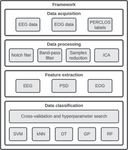Cognitive Computation ( IF 5.4 ) Pub Date : 2024-01-11 , DOI: 10.1007/s12559-023-10233-5 José Manuel Hidalgo Rogel , Enrique Tomás Martínez Beltrán , Mario Quiles Pérez , Sergio López Bernal , Gregorio Martínez Pérez , Alberto Huertas Celdrán

|
Driver drowsiness is a significant concern and one of the leading causes of traffic accidents. Advances in cognitive neuroscience and computer science have enabled the detection of drivers’ drowsiness using Brain-Computer Interfaces (BCIs) and Machine Learning (ML). However, the literature lacks a comprehensive evaluation of drowsiness detection performance using a heterogeneous set of ML algorithms, being also necessary to study the performance of scalable ML models suitable for groups of subjects. To address these limitations, this work presents an intelligent framework employing BCIs and features based on electroencephalography for detecting drowsiness in driving scenarios. The SEED-VIG dataset is used to evaluate the best-performing models for individual subjects and groups. Results show that Random Forest (RF) outperformed other models used in the literature, such as Support Vector Machine (SVM), with a 78% f1-score for individual models. Regarding scalable models, RF reached a 79% f1-score, demonstrating the effectiveness of these approaches. This publication highlights the relevance of exploring a diverse set of ML algorithms and scalable approaches suitable for groups of subjects to improve drowsiness detection systems and ultimately reduce the number of accidents caused by driver fatigue. The lessons learned from this study show that not only SVM but also other models not sufficiently explored in the literature are relevant for drowsiness detection. Additionally, scalable approaches are effective in detecting drowsiness, even when new subjects are evaluated. Thus, the proposed framework presents a novel approach for detecting drowsiness in driving scenarios using BCIs and ML.
中文翻译:

使用脑电图通过可扩展的机器学习模型研究驾驶时的睡意检测性能
摘要
驾驶员困倦是一个重要问题,也是交通事故的主要原因之一。认知神经科学和计算机科学的进步使得能够使用脑机接口 (BCI) 和机器学习 (ML) 来检测驾驶员的睡意。然而,文献缺乏使用一组异构机器学习算法对睡意检测性能进行全面评估,也有必要研究适合受试者群体的可扩展机器学习模型的性能。为了解决这些限制,这项工作提出了一种智能框架,采用 BCI 和基于脑电图的功能来检测驾驶场景中的睡意。SEED-VIG 数据集用于评估各个受试者和群体的最佳表现模型。结果表明,随机森林 (RF) 的性能优于文献中使用的其他模型,例如支持向量机 (SVM),单个模型的 f1 分数为 78%。关于可扩展模型,RF 达到了 79% 的 f1 分数,证明了这些方法的有效性。该出版物强调了探索适合受试者群体的多种机器学习算法和可扩展方法的相关性,以改进困倦检测系统并最终减少因驾驶员疲劳引起的事故数量。从这项研究中吸取的教训表明,不仅支持向量机,而且文献中未充分探索的其他模型也与睡意检测相关。此外,即使在评估新受试者时,可扩展的方法也能有效检测睡意。因此,所提出的框架提出了一种使用 BCI 和 ML 检测驾驶场景中困倦的新方法。



























 京公网安备 11010802027423号
京公网安备 11010802027423号